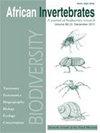马达加斯加Diaphorocellus Simon二新种记述(蜘蛛目,蜘蛛科)
IF 1.1
4区 农林科学
Q3 ENTOMOLOGY
引用次数: 1
摘要
两个新物种的须线属Diaphorocellus Simon,1893,D.isalosp.nov(♂♀), 和D.jocquisp.nov(♂♀), 分别来自马达加斯加中部和东部。与D.rufus(Tullgren,1910)一起,这些新物种可以通过腹部有精细而密集的斑点来与其他同类区分开来。它们彼此不同,也不同于D.rufus,因为它们的眼群结构以及雄性和雌性交配器官的结构不同。提供了表现D.isalosp.nov.和D.jocquisp.nov.诊断特征的诊断和插图。该属目前包括六个非洲物种。本文章由计算机程序翻译,如有差异,请以英文原文为准。
Two new species of Diaphorocellus Simon, 1893 from Madagascar (Araneae, Palpimanidae)
Two new species of the palpimanid genus Diaphorocellus Simon, 1893, D.isalosp. nov. (♂♀), and D.jocqueisp. nov. (♂♀), are described from central and eastern parts of Madagascar, respectively. Along with D.rufus (Tullgren, 1910), these new species can be distinguished from other congeners by possessing a finely and densely spotted colouration of the abdomen. They differ from one another, as well from D.rufus, by the eye group configuration and by the structure of the male and female copulatory organs. Diagnoses and illustrations presenting the diagnostic characters of D.isalosp. nov. and D.jocqueisp. nov. are provided. The genus now includes six African species.
求助全文
通过发布文献求助,成功后即可免费获取论文全文。
去求助
来源期刊

African Invertebrates
生物-动物学
CiteScore
1.00
自引率
0.00%
发文量
6
审稿时长
>12 weeks
期刊介绍:
African Invertebrates is an international peer-reviewed, open-access journal that focuses primarily on the taxonomy, systematics, biogeography, and palaeontology of Afrotropical invertebrates, whether terrestrial, freshwater or marine. Aspects concerning biology, ecology, and conservation may also be considered where these relate to the primary focus areas. Papers dealing solely with biology, ecology, physiology, pests and pest control should be submitted elsewhere.
 求助内容:
求助内容: 应助结果提醒方式:
应助结果提醒方式:


